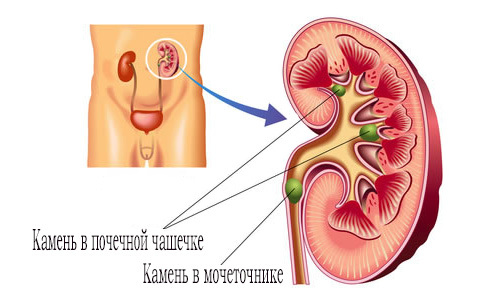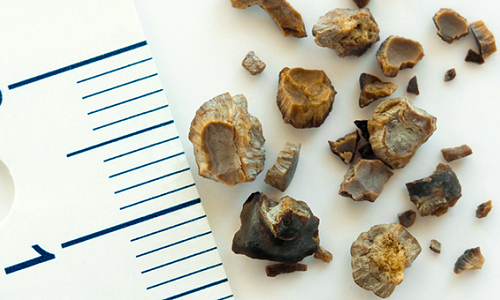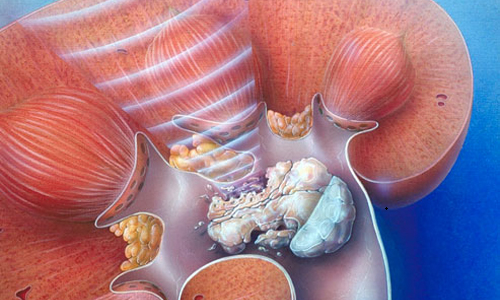Renal stones do not appear in one day, this is preceded by a rather long process in which kidneys form smaller concretes like sand and small stones. Microlithiasis( this is the name of this disease) usually does not cause particular concern to a person, but over time they can increase and turn into larger stones that are much more difficult to treat. Microliths in the kidneys can form outside the age range, which can only affect the chemical composition of the stones. In the elderly, for example, stones with a uric acid content are formed more often.

Reasons for the formation of microlites
In fact, microliths in the kidneys are considered by specialists as the initial stage of urolithiasis. The reasons for this state are many:
- Drinking too hard water;
- Violations of material exchange, having a hereditary nature;
- Endocrine disorders;
- Pathological conditions of bone tissue, leading to a high level of calcium in the body, such as osteomyelitis, osteoporosis or fractures;
- Genetically determined tendency to macrolith formation;
- Abuse of foods that increase the acidity in urine( sharp, acidic or too salty foods);
- Insufficient water intake;
- Chronic pathologies of the gastrointestinal tract and genitourinary system such as ulcers, gastritis, pyelonephritis or prostate adenoma;
- Disorders of parathyroid glands;
- Structural abnormalities of the urinary system, which promote renal stagnation of urine and salt retention;
Vitamin D deficiency and other hypovitaminosis; - Microliths in the kidneys are more often formed living in dry and hot climatic conditions( geographical factor).
Symptoms of microlithiasis
The formation of minute concrements and sand in the kidneys is not considered as dangerous, unlike stone formation, although the signs for these conditions are almost identical. If sand accumulates in larger stones, this can lead to a strong soreness, localized in accordance with the location of the microlite. These small stones can move freely through the urinary system. Since they do not always have a smooth surface, having various growths and spinules on it, when moving, microliths can cause trauma to the mucosa. A similar pathological process is usually accompanied by a pain syndrome in the perineum and impurities of blood in the urine.

If the pain syndrome concentrates in the lower abdomen, this indicates the progress of the microlith in the ureter. The patient begins to experience frequent urge to go to the toilet, there is a strong burning sensation, and the urination process becomes painfully painful and uncomfortable. The presence of microliths can also be indicated by the changed color of urine. In a healthy person, it is clear and liquid, and the content of calculi makes the urine cloudy.
The most common sign of the appearance in the kidney of microliths is pain, which can be acute or blunt, cutting or stitching. Pain syndrome is localized in the lumbar region, radiating into the groin and genital organs.
The characteristic pain syndrome is unstable. Usually, painful sensations appear in the lumbar region when the posture changes, turning the body or tilting. Often arising in such circumstances, soreness is mistaken for osteochondrosis. If after the reception of No-shpa the pain goes away, it means that its primary cause was a kidney, because with osteochondrosis such a drug will not help get rid of the pain syndrome.
Microliths in the kidneys can be localized on either side or be of a one-sided nature. Right-sided localization of renal calculi is accompanied by symptoms similar to acute appendicitis, hepatic or biliary lesions, as the pain syndrome concentrates in the groin and lower abdomen. The left-side arrangement of small calculi appears only when the grains grow to a few millimeters. The patient begins to worry about lumbar pain, which is aggravated by stress or change of posture. Two-sided localization of microliths suggests a common pathology of the organism, associated with malnutrition and violation of the processes of material exchange.
Treatment methods
The treatment process usually starts with thorough diagnostic tests. On the diagnostic results, the necessary treatment plan is selected. In general, therapy can have a medicamental or dietary orientation.

Warning! Categorically, you can not independently designate funds intended for the dissolution of microliths, since they are capable of breaking only a certain variety of stones, which only a qualified specialist can establish.
Conservative treatment of
The main direction of conservative treatment is the dissolution and excretion of hydrochloric crystals and microliths along with urine. For this purpose, funds are allocated for crushing stones and drugs with a diuretic and antispasmodic action that helps in their elimination. If the infection of the urinary system is infectious in the process of formation of microliths, the main treatment is supplemented with antibacterial and anti-inflammatory agents.
Important! You can not neglect the therapeutic measures of microliths, because in the future concrements will become larger and cause many complications, such as abnormal enlargement of renal cavities, colic or insufficiency. And large stones can be removed only through surgical intervention.
Since the frequent cause of calculus formation is a violation of material metabolism, a copious drinking regime is simply necessary for a good washing of the kidneys. The doctor, taking into account the type of stones, appoints the preferred diet. Treatment of microliths usually does not involve surgery, since the salt particles are too small. The need for surgical care arises if microliths obstruct the urinary tract.
Specificity of food
Microlytes in the kidneys require a special diet, so patients are advised not to use broths based on meat, mushrooms or fish, they are prohibited from eating canned foods, smoked and sausage products, pickles and sorrel, beans and spinach, offal, cheeses and so on. It is necessary to limit the use of honey, salt and spicy herbs like coriander and dill, basil and parsley. A more detailed diet is made in accordance with the basic composition of the stones.
If the basis of microlites is mainly carbonates, it is desirable to minimize the content of foods with a high content of calcium - cheese, cottage cheese or milk, yogurt. But boiled meat or stewed fish, eggs and cereals with such stones form the basis of the diet. In the case of the phosphate base of microlites, it is recommended to limit the consumption of fruits, dairy products, vegetables, preferring vegetable oil and flour products, lean fish and meat dishes.
With strict adherence to dietary prescriptions, it is entirely possible to completely dissolve and remove microlits from the body. In addition, a special diet will avoid urolithiasis.
The urate nature of microliths shows a strict limitation of fish and meat products, liver and kidneys, vegetable fats. Stones with an oxalate base require the exclusion from the diet of foods rich in oxalic acid: milk and potatoes, oranges and sorrel, coffee or chocolate. Patients with microliths are recommended to drink more liquid, it is advisable to drink herbal teas, compotes from dried fruits or berries. Effectively removes salt from the buds of wild rose compote and watermelon.
The main preventive principle is a sufficient drinking regime. In summer, due to severe sweating, dehydration of the body occurs, which weakens the leaching of salts from the body. As a result, the stone-forming process is markedly accelerated. Therefore it is important to drink more tea from herbs, mineral water, freshly squeezed juices.



